A History of the County of Northampton: Volume 4. Originally published by Victoria County History, London, 1937.
This free content was digitised by double rekeying. All rights reserved.
'Parishes: Broughton', in A History of the County of Northampton: Volume 4, ed. L F Salzman (London, 1937), British History Online https://prod.british-history.ac.uk/vch/northants/vol4/pp158-162 [accessed 31 January 2025].
'Parishes: Broughton', in A History of the County of Northampton: Volume 4. Edited by L F Salzman (London, 1937), British History Online, accessed January 31, 2025, https://prod.british-history.ac.uk/vch/northants/vol4/pp158-162.
"Parishes: Broughton". A History of the County of Northampton: Volume 4. Ed. L F Salzman (London, 1937), British History Online. Web. 31 January 2025. https://prod.british-history.ac.uk/vch/northants/vol4/pp158-162.
In this section
BROUGHTON
Bructon, Burtone, Bruton (xi cent.); Brocton (xiii cent.).
Broughton lies to the south of Cransley, and has Kettering to the east of it, its northern boundary for some distance being the Northampton to Kettering road. The village, which is large, lies where this road bends to run south through the parish, and is situated between it and another main road connected here by smaller streets. It contains several good houses, and lies at a height of about 425 ft., the ground falling to about 325 ft. at the southern extremity of the parish.
Saint Andrew's Church lies at the eastern end of the southernmost of the above-mentioned connecting roads.
West of the church is a large two-storied stone house known as 'The Gables', with mullioned windows, thatched roof, and main end gables and two smaller intermediate ones on the principal, or north, front: a panel in the eastern gable is inscribed 'w. f., 1685'. On the south side of the main road is a 17th-century house of ironstone which though altered and in part mutilated for road-widening purposes retains much of its original picturesqueness: it is of two main stories, with mullioned windows and high-pitched thatched roof containing attics lighted by windows in the end gables and there is a smaller gable on the west front at the angle of the building. Near the west end of the High Street is a modernized two-story house with thatched roof and panel in the end gable inscribed 'TpE, 1705'.
The school was built in 1870, and rebuilt in 1892 for 135 children. The churchyard was enlarged in 1860; and in 1900 a cemetery of an acre was formed and is under the control of the parish council.
The population is mainly collected in the village, which has near it on the north-west Churchill Spinney and an old quarry. Away by itself at the eastern side of the parish is Broughton Lodge, a fine old house. When Newton House (in Newton-in-the-Willows) was demolished, about 1800, portions of the material were used in this house, then a farm-house, where many years before the last of the Newton Treshams had lived. (fn. 1) Near by is Clarke's Lodge.
The Union Dissenting chapel was built in 1851 for various denominations.
A disastrous fire visited Broughton in 1701, when briefs were issued to assist in reconstruction. (fn. 2) The church fortunately escaped. Its rectors have been men of note. They include: Robert Bolton (1610–1631), the father of Dr. Samuel Bolton who was chaplain to Charles II, 'a grave and comely person'—according to Fuller—'an authoritative preacher who majestically became the pulpit'; and the wise and witty Royalist divine, Joseph Bentham (1632–1671), who wrote in 1657 'Two Breife but Usefull Treatises: the one touching the office and quality of the Ministry of the Gospel: the other of the Nature and Accidents of Mixt Dancing'. After much suffering during the Civil Wars, he came back to his old parish at the Restoration, where he died in 1671, as an inscription on a stone within the altar rails shows. He left in his will £40 to be distributed annually for ever among the poor at Broughton on the happy day of His Majesty's restoration, and 10s. to be given yearly in the church porch, at Weekley, to such poor persons as should come to church on the 29th of May.
The population, which was 374 in 1801, in 1931 was 1,207. (fn. 3) The parish has an area of 1,742 acres. Part of the soil is of a stiff, clayey nature, and of the subsoil ironstone. The chief crops grown are wheat, beans, and sugar-beet.
Manor
One and a half hides of socland in Broughton were valued in the Domesday Survey with a hide in Cransley and 3 virgates in Hannington among the Countess Judith's land, (fn. 4) and descended with her other lands in the honor of Huntingdon.
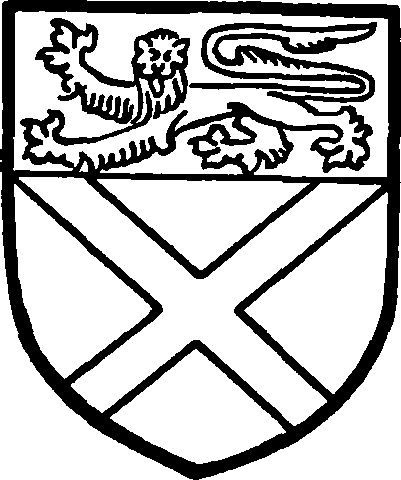
Bruce. Or a saltire and a chief gules with a leopard or in the chief
Robert Bruce in 1284 held a fee in BROUGHTON of the king in chief, this fee being held under him by Walter de Huntecumbe, of Walter by Geoffrey de Leuknor, and of Geoffrey by William de St. German, (fn. 5) the under-tenant by whose family it was held for several centuries. In 1378 this fee was among those lately held of Edward Prince of Wales by Simon Simeon in succession to Geoffrey Leuknor. (fn. 6) The overlordship of the manor was returned in, 1485 as unknown, (fn. 7) but was ascribed in 1522 to Rothwell Manor, (fn. 8) which was at the time in the hands of Sir William Parr by a grant for 40 years, after the attainder of Edward Duke of Buckingham. (fn. 9) It was returned as held of the king as of his manor of Rothwell in 1615. (fn. 10) Apparently the intermediate lordships had lapsed during the 15 th century and the property had been combined with the half hide in Broughton which at the time of the Domesday Survey was a member of the royal manor of Rothwell. (fn. 11)
The first St. German under-tenant in Broughton recorded was Robert, who held 2 carucates there in 1229. (fn. 12) William de St. German was lord of Broughton in 1252 (fn. 13) and was dealing with land there in 1260. (fn. 14) William de St. German, presumably identical with the coroner for the county of Northampton, (fn. 15) claimed view of frankpledge in Broughton in 1276, (fn. 16) and, as already stated, was holding the manor in 1284. A William de St. German was holding Broughton in 1316, (fn. 17) and in 1329 he or a namesake with his wife Margaret settled the manor upon themselves and their heirs; (fn. 18) later in the same year he paid a fine of half a mark to recover view of frankpledge there. (fn. 19) In 1428 Thomas de St. German was holding the fee in Broughton which William had formerly held. (fn. 20)
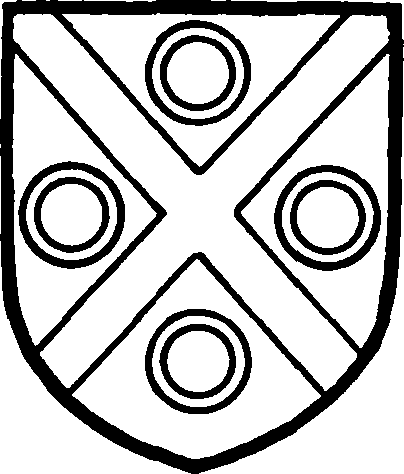
St. German. Azure a saltire or between four rings argent.
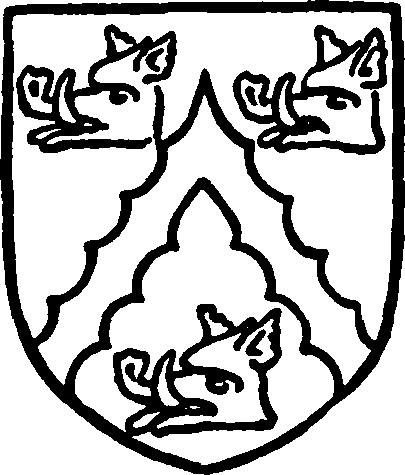
Agard. Argent a cheveron engrailed gules between three boars' heads sable.
The last under-tenant of the name was Geoffrey St. German (Sengermyn), who died on 22 August 1485. (fn. 21) By deed dated 10 April 1465 he had settled the manor on trustees, who on 10 October 1485 enfeoffed of the same Thomas Agard and his wife Margaret, the daughter and heir of Geoffrey, then aged eighteen. (fn. 22) It was then worth 5 marks, and was not held of the king, but its tenure was unknown. Thomas and Margaret with John Agard in 1497 conveyed the manor, then described as the manor of BROUGHTON SEYNT FERMYN to Edmund Grevyle and others by fine. (fn. 23) On 18 May 1522 George Agard, son and heir of Thomas and Margaret, died seised of the manor, mill, &c, which he had settled on his wife Elizabeth, with remainder to his son John; he was also seised of a life interest in certain tenements after the death of Christopher St. German, with remainder to George's son, Stephen, his heir, aged nine at George's death. (fn. 24)
Besides George, the heir, Thomas and Margaret had had two other sons, Edward and Nicholas. They subsequently instituted proceedings against Edward Warner, (fn. 25) who married George's widow and executrix Elizabeth. The result is a valuable chapter of family history. The complaint of the brothers Agard begins with the statement that Geoffrey St. German had forfeited his lands by attainder of treason, after fighting at Bosworth Field against Henry VII; but long before his attainder he had granted the manor to one Sir William Tyler. When his daughter and heir Margaret had been married to Thomas Agard, John brother of the said Thomas had redeemed the manor and lands from Sir William Tyler for £400, and conveyed it to the use of Thomas and Margaret and their heirs. Thomas died leaving unpaid of the said £400 the sum of £83, which John in his will directed should be divided equally between the plaintiffs. George, the son and heir, granted an annuity of £4 to Edward, and of 40s. to Nicholas, who delivered the indentures of agreement to Edward Warner, in whom they had special confidence, he being learned in the law. After they had enjoyed the annuities for three years, George died, and Elizabeth with Edward Warner, whom she had then married, refused payment of the annuities. Edward stated that Thomas Agard, having neither goods nor lands, but being a wildly disposed young man, came with other evil-disposed persons to Clerkenwell by London, where Margaret was by the commandment of her father, and in the night time, privately led her away and married her, whereby her father lost the marriage of his only daughter and heir, for whom great sums had been offered by men of great possessions.
'And the saide Geffery perceived grete lightnes and wildenes in the saide Thomas Agard after he had married his saide daughter and accomptyd hir lost and cast away and thereupon fell in grete sorrow and sadenes and had smale comfort which was the cause whereupon the saide Geffery rode to Kyng Rychards felde and ther by misfortune was slayne and as some persones surmysed by the means of the seid Thomas Agard and others of his affinitye ther being at the seid felde and in grete malyce with the seyd Geffery Seyntgerman for such trobulls as the seid Geffery had put him to for the marriage of the saide daughter.'
After the death of her father and birth of her children, Thomas Agard deserted his wife 'reputyd and taken for as good vertuse and as sade a woman as any was within the Shyer of Northampton' who lived in a cottage 'in her lordship of Broughton in as great poverte as a woman might be having such fere possessions so that she lyved of almes and helpe of her frends', while Agard in her lifetime sold all her inheritance except the manor of Broughton, where he demised lands to one Henry Packe of Kettering, pledged all the evidences of her inheritance, and then died at Westminster in great debt. His son George, according to Edward Warner, had recovered part of these lands, which were being applied by his widow and her husband to the maintenance of his children. The lease referred to appears to have been made to Henry Packe of Kettering by Thomas Agard, his wife Margaret, and son George in return for money advanced to procure the release of Thomas Agard from imprisonment in the Fleet for debt. (fn. 26) Stephen, returned as lord in 1546, (fn. 27) married Elizabeth, daughter to William Raynsford of Tew in co. Oxford, widow of Robert Belcher, by whom he had a son Ambrose and two daughters, Jane married to Richard Wycherley of Wycherley, and Elizabeth who married Harold Kinnesman of Broughton, 'Vicetreasurer at armes in the Irish Warrs'. (fn. 28) At his death in 1562, Stephen Agard was succeeded by his son Ambrose, who in 1588 contributed £25 to the defence of the country against the Spanish invasion. (fn. 29) A conveyance of the manor was made by Ambrose on 20 March 1591 to Francis Barnard, Christopher Smyth, and John Doyley, 'all alyed in kindred with him', to the use of Ambrose for life, with remainder to his son and heir Stephen, in order to secure an annuity of £20 to any wife he might afterwards marry; after which he married a wife Anne (who also had children by a previous marriage). (fn. 30) Ambrose's son Stephen conveyed the manor to Sir Augustine Nicholls, justice of the King's Bench, (fn. 31) who with his wife Dame Mary sold it in 1613 to John and Henry Cotton. Henry Cotton, esq., died on 11 June 1616, when John, his brother, described as of London, gent., was still living at Broughton. The heirs of Henry were his sisters Katharine Cotton, widow; Frances, wife of Sir Edward Montagu of Boughton; and Rebecca, wife of William Mulsho of Finedon, aged, respectively, 24, 23, and 22 at their brother's death. (fn. 32) The manor was next held in thirds by these heirs and their representatives. In March 1617–18 Sir Edward Montagu and Frances his wife, and William Mulsho and Rebecca his wife were dealing by fine with two-thirds of the manor, advowson, frankpledge, &c.; (fn. 33) and by his will proved on 16 June 1646 Sir Edward Montagu bequeathed his third to his grandson Sir Edward Montagu, (fn. 34) who in 1659 conveyed it to Thomas Kipps. (fn. 35) A conveyance was made in 1628 of the manor of Broughton by John Tullakerne to Thomas Tullakerne, (fn. 36) and in 1665 by John Tullakerne and Martha his wife and Thomas Cory and Elizabeth his wife to Thomas Harris and John Neale. (fn. 37) According to Bridges, Rebecca Gooday, widow, formerly wife of William Mulsho, and William Mulsho her second son sold the Mulsho third of the manor in 1648 to Edward Lord Montagu. (fn. 38) It was presumably therefore Katharine Cotton's third which had been dealt with by the Tullakernes, and which in 1702 John Farrow and Dinah his wife, Ellis Farrow, Theophilus Dillingham and Mary his wife, John Bigg and Rebecca his wife, Samuel Watts and Elizabeth his wife, and Robert Miller conveyed to Benjamin Styles and Robert Hewett, (fn. 39) with one-third of the advowson, and of which John Farrow and Dinah his wife and Benjamin Styles and Elizabeth his wife made a conveyance in 1704 to William Farrow. (fn. 40) Two-thirds of the manor and advowson were dealt with by recovery in the same year by Ralph Earl of Montagu and John Montagu, his son and heir apparent, (fn. 41) the whole ultimately being in the hands of the Duke of Montagu. John Duke of Montagu (d. 1749) married Mary the fourth and youngest daughter and co-heir of the great Duke of Marlborough, and the death without issue of their only son in his father's lifetime resulted in the division of this property between their daughters and coheirs: Isabella who married first the Duke of Manchester and second Edward Hussey-Montagu, created Baron Beaulieu of Beaulieu in 1762, and Mary who married George Brudenell, 3rd Earl of Cardigan, subsequently created Duke of Montagu. As George Earl of Cardigan the latter was in 1760 holding one moiety of Broughton with his son John, who also died s.p. in 1770 in the lifetime of his father. Elizabeth, the only daughter and heir of George Duke of Montagu (2nd cr.), married Henry Scott, 3rd Duke of Buccleuch, and one moiety of Broughton was held in 1776 by George Duke of Montagu and by his son-in-law Henry Duke of Buccleuch, and his wife Elizabeth, (fn. 42) the other half being then, and in 1786, (fn. 43) in the hands of Edward Earl of Beaulieu and his wife Isabella. By the death s.p. on 25 November 1802 of Edward Earl of Beaulieu, the two moieties came together again under the Dukes of Buccleuch, the present owner being the 8th duke.
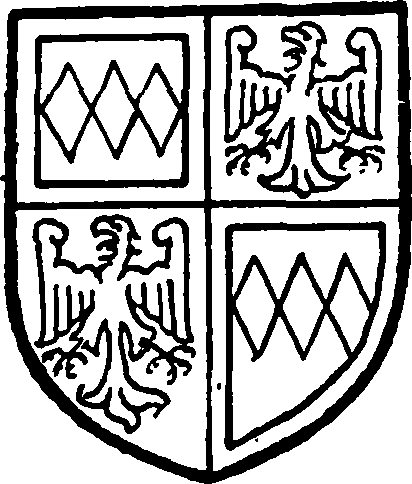
Montagu. Argent a fesse indented of three points gules in a border sable, quartered with or an eagle vert.
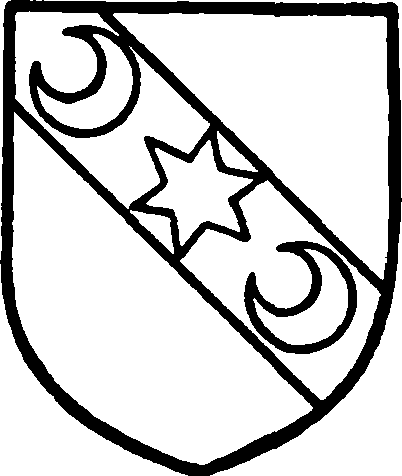
Scott, Duke of Buccleuch. Or a bend azure with a molet between two crescents or thereon.
In an inspeximus dated 18 May 1328 for the abbess and nuns of St. Mary's, Northampton, or Delapré, lands in Broughton, given by Reynold son of Thomas de Broughton, and by Alexander son of Reynold de Broughton, were included, (fn. 44) and rents from Broughton Mill. These were granted on 21 December 1545, as the NUNLANDS, in the occupation of John Hichecok, 3 selions of which lay in Middlefield, to Thomas Thoroughgood and John Foster, (fn. 45) a fresh grant of the same property and of the rectory and advowson being made to Sir Thomas Tresham and George Tresham in 1551. (fn. 46)
A rent of 4s. yearly in Broughton was granted by Hugh son of Alfred de Dingley to the nuns of Sewardsleye. (fn. 47)
Church
The church of ST. ANDREW consists of chancel, 33 ft. 9 in. by 16 ft. 3 in.; clerestoried nave, 44 ft. 9 in. by 17 ft.; north aisle, 10 ft. 6 in. wide; south aisle, 12 ft. 10 in. wide; north and south porches, and west tower with broach spire, 9 ft. 6 in. by 9 ft. 3 in., all these measurements being internal. The width across nave and aisles is 44 ft. 9 in., the 'body' of the church being thus exactly square.
The original church was a 12th-century aisleless building with nave covering the same area as at present, the north-east and south-east quoins of which remain in situ, but the south doorway was moved outward when the aisle was added. A flat buttress at the southwest angle of the nave, close to the tower, is also part of the early building. The doorway has a semicircular arch of two orders and hood-mould, the outer order on nook-shafts and ornamented with a plain chevron, the inner with lozenge and pellet ornament, on plain jambs and chamfered imposts; the capital of the east shaft is carved, the other scalloped.
The north doorway is of the 13th century, and there is a blocked lancet above the south porch towards the west, but whether either of these is in its original position is uncertain, though aisles may have been added (fn. 48) at this period and subsequently rebuilt. In their present form the aisles and arcades are of the early part of the 14th century, and appear to have followed the rebuilding of the chancel c. 1290–1300, and the erection of the tower c. 1300–10. The clerestory and north porch are of the 14th century, but the south porch has been largely rebuilt and its front is modern. The chancel was rebuilt in 1828, (fn. 49) but much of the old work was retained, the windows and other architectural features being rerused. The church was restored in 1854.
The chancel is faced with roughly dressed coursed ironstone and has a stone-slated eaved roof. The aisles are of rubble and together with the nave have lowpitched leaded roofs behind plain parapets, except on the north side where the lead overhangs. The clerestory is of coursed stone. Both porches are gabled and have slated roofs.
The chancel has a late-13th-century east window of five lights with intersecting tracery and quatrefoiled circle in the head, moulded jambs, and hood-mould with head-stops. The lower part of the east wall, with dwarf coupled buttresses, appears to be old, and has a chamfered string-course. There is a contemporary moulded doorway in the north wall, (fn. 50) and west of it a plain rectangular low-side window with chamfered edges, (fn. 51) but otherwise the wall is blank. In the south wall are two pointed windows of two trefoiled lights, the easternmost much restored with quatrefoil in the head, the other traceried and wholly new. Internally the sill of the easternmost window is lowered to form two graded seats, (fn. 52) and at the east end of the north wall is a restored trefoiled aumbry. The walls, as elsewhere in the church, are plastered. The 14th-century chancel arch is of two chamfered orders, the inner on halfoctagonal responds, with moulded capitals and bases.
The nave arcades are of three bays with arches of two chamfered orders springing from octagonal piers with moulded capitals and bases. The arches were cut through the older wall leaving a 5 ft. length of masonry at each end on either side, but the south arcade seems to be the earlier, its piers being more massive and differing in detail from those opposite. At the east end of the north arcade there is a half-octagonal respond, but at the west and on the south side the arches spring from corbels, that at the north-west supported by a mask, the others moulded. There are hood-moulds on the south side only, and the piers stand on square plinths. Two rood-loft doorways remain, one high up north of the chancel arch, the other (blocked) to the stairs at the east end of the south aisle, about 2 ft. 6 in. above the floor.
All the windows of the aisles are square-headed and of three trefoiled lights. The 13th-century north doorway is of three orders, the innermost with a continuous sunk quarter-round, the others moulded on shafts with moulded capitals. (fn. 53) The outer doorway of the porch is of a single continuous wave-moulded order and hoodmould with head-stops. The modern front of the south porch has a doorway with stone lintel.
The nave roof is of four equal bays spaced irrespective of the arcades; there are three square-headed clerestory windows of two trefoiled lights on each side, the western roof-bay being blank.
The tower has a moulded plinth and coupled buttresses of three stages, but is without string-courses, and on the north side is blank. On the west is a three-light ogee-headed window with hood-mould and intersecting tracery and above it a small trefoil-headed opening, while high up on the south side is a tall trefoiled lancet. The arch to the nave is of three chamfered orders, the inner on half-octagonal responds with moulded capitals and bases. There is no vice. The pointed bellchamber windows are of two trefoiled lights with quatrefoil in the head, moulded jambs, and slightly ogee label. The spire rises from a corbel table of heads and has plain angles and two tiers of openings on the cardinal faces, the lower of two cinquefoiled lights with quatrefoil in the head. The broaches are very small.
The late-14th-century font has an elaborately carved octagonal bowl, and pedestal with traceried panels and angle shafts. The pulpit is of Caen stone, erected in 1867.
On the north wall of the chancel is the monument of Robert Bolton (d. 1631), described as 'Primus et optimus huius ecclesiae praeco doctissime pius', with half-length bust under a semicircular canopy; and on the south wall the bust and monument of Harrold Kynnesman (d. 1631), 'sometime vice-treasurer at armes in the Irish warres in the reign of Queen Elizabeth and for his singular fidelity recalled to the same office in the reign of King James'. There is also a wall tablet to Zachary Rose, rector (d. 1790), and one in the nave to Mrs. Elizabeth Henchman (d. 1772), whose charity is recorded, with others, below the tower.
There is some old glass in the east window of the south aisle, comprising two shields of arms (fn. 54) and three small heads in yellow and white.
There are five bells, the first, second, third, and tenor by Henry Penn of Peterborough, 1709, and the fourth by Robert Taylor of St. Neots, 1803. (fn. 55)
The plate consists of a silver paten of 1682, a cup of 1683, a paten of 1721 by Joseph Clare, and a flagon of 1770 by Charles Wright, the gift of Mrs. Ann Mappletoft in 1771. (fn. 56)
The registers before 1812 are as follows: (i) baptisms 1560–1631, marriages 1570–1627, burials 1559– 1627; (ii) baptisms, marriages, and burials 1632–43, 1653–1746; (iii) baptisms and burials 1746–1812, marriages 1746–55; (iv) marriages 1754–1812. The first volume is much mutilated: the second volume contains a terrier of glebe lands 10 May 1672. There are churchwardens' accounts 1670–1793.
Advowson
The church was granted by Roger de Clare, Earl of Hertford, to the convent of Delapré, this grant being confirmed by Robert, Bishop of Lincoln, and by Edward III again on 18 May 1328. (fn. 57) It was valued in 1291 at £7 6s. 8d. (fn. 58) The profits of the rectory, then leased to Alfred Baxter, were returned as £22 yearly in 1535. (fn. 59)
The advowson was held by the convent of Delapré from at least 1227 (fn. 60) until the Dissolution. It has frequently been leased for one turn (fn. 61) both before and after the Dissolution. (fn. 62) After being granted with the Nunlands (q.v.) to Sir Thomas Tresham, it was acquired by the lord of the manor, and was included in the sale of the manor to John and Henry Cotton by Sir Augustine Nicholls in 1613. It was held with the manor until 1920, when it was transferred by the Duke of Buccleuch to the Bishop of Peterborough.
When the parish was inclosed in 1786, an allotment of 320 acres was made for tithes and for the glebe.
Charities
Edward Hunt's Charity founded by will proved at Northampton 7 December 1674 is described under the parish of Warkton. Stock producing £9 5s. 4d. yearly in dividends represents the endowment for this parish.
The Poor's Land. An allotment of about 14 acres was set out in the inclosure in lieu of land formerly given to the poor. The land produces about £24.
Bentham's Charity. It is stated in the accounts for the year 1870 that the rector and churchwardens are the trustees of a sum of £40 left by Mr. Bentham for the poor. The money is invested on mortgage and £2 yearly is received in interest.
Church Estate. An allotment of about 17 acres was set out on the inclosure in lieu of lands anciently appropriated to the repairs of the church. The land is let for £23 13s. yearly which is applied by the churchwardens to church expenses.
Mrs. Elizabeth Henchman, who died in 1772, left £40 for poor widows who attend church. The money was applied towards making new pews in the parish church and in respect of it £2 is distributed by the churchwardens to about 16 poor widows.
Sarah Keyston on 5 November 1841 deposited £10 in the Kettering Savings Bank on trust to the rector and churchwardens to distribute the income to poor widows of 50 years and upwards, members of the Church of England. The money was eventually invested and the endowment is now £9 16s. 3d. Consols producing 4s. 8d. annually in dividends, which sum is distributed equally among 6 poor widows.
The Rt. Hon. James Lord Douglas by deed of directions dated 7 April 1852 directed the trustees of his will to pay the sum of £1,000 to the rector and churchwardens to be invested in the Public Funds and the interest to be distributed amongst the poor. The endowment now produces £26 7s. yearly. The income is distributed in money payments by the rector and two trustees appointed by the Parish Council in place of the churchwardens.
